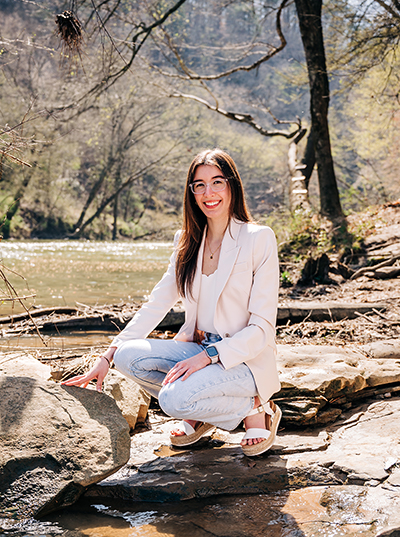By Matt Windsor
When she was in high school in Houston, Texas, Daniela De Nobrega was “all over the sciences,” she said. “Calculus, statistics, physics — I liked them all. So when I got to college, I wanted to find a major that offers a little bit of everything.” That is how she ended up as a biomedical engineering major in the UAB School of Engineering. “Biomedical engineering is challenging but also encouraging,” said De Nobrega, who is a sophomore and member of the UAB Honors College Personalized Honors Program. “It makes you want to keep learning.”
Last summer, De Nobrega needed to find a job to help pay for her studies, but she also hoped to keep learning, as well. “I found out about the Research Experiences for Undergraduates program” from the National Science Foundation, she said. “You get to work in a lab for two to three months, you are assigned your own project, and they pay you while you work.”
Not your typical summer job
Perfect. But there was a problem: “I had no hope of getting in,” De Nobrega said. “One requirement is to be a sophomore or junior, and I was a freshman.” Still, she worked with Molly Kate Lallone in the UAB Engineering Career Center on her resume and application and applied to a few different labs in Texas. “I got into one, and that was very exciting,” she said. “The Engineering Career Center was a great help.”
De Nobrega joined the lab of Tyrone Porter, Ph.D., a biomedical engineer at the University of Texas at Austin who is focused on innovative uses of ultrasound technology for image-guided drug delivery. (While De Nobrega was there, Porter was named chair of the Department of Biomedical Engineering at UT Austin.) “I was interested in learning more about how biomedical engineering is related to nanotechnology and the challenges that come with working at the nanoscale,” De Nobrega said.
Over the summer, she learned about the promise and challenges of nanoscale work firsthand. “I was working on the synthesis of lipid nanoparticles as drug-delivery mechanisms for potential use in cancer treatments,” De Nobrega said. “The first few weeks in the lab were reading and learning. We were using two different types of nanoparticles — one artificially made and one collected from cells. Both are lipid-based. I created the artificially made nanoparticles — you combine lipids together, dry them until there is only a thin layer at the bottom of the flask, put in a buffer solution and then shake them really fast. We pushed them through a membrane to get the different sizes we wanted. With the help of my mentor, I was also able to collect the nanoparticles made from cells.”
The work might sound tedious, but it was actually “really fun,” De Nobrega said. “It was a challenge — I just put in my earbuds in and got into it. Plus, I really wanted it to work out.”
When the summer was drawing to a close, De Nobrega presented her results at a poster session at UT Austin. “My mentor and PI then encouraged me to present my results at the Biomedical Engineering Society Conference in October of last year,” De Nobrega said. “UT Austin helped me travel from Birmingham to the conference to present my work.”
Putting it all together
De Nobrega says her lab experience also is paying dividends as she begins her biomedical engineering courses. “This semester, we have been learning all about research methods in biomedical engineering, many of which I learned about over that summer,” she said. “Now I know more about why I was doing what I was doing, and the theory behind it. I understand the specifics, and it puts a lot of things together.”
For now, De Nobrega plans to go on to graduate school after she earns her undergraduate degree. “I loved my time during the REU, and it has encouraged me in pursuing research and potentially a career in academia,” she said. “I am still figuring out what I want to pursue in my graduate studies. I am debating on whether to go more into the engineering route or more into the health care/mental health route.”
